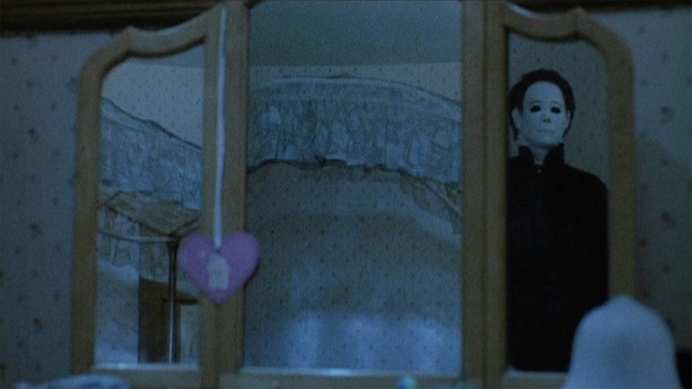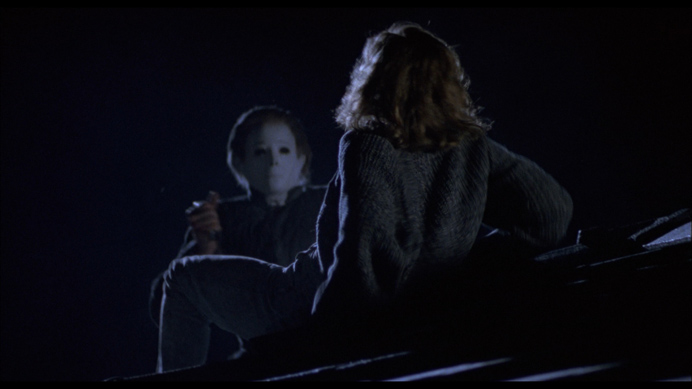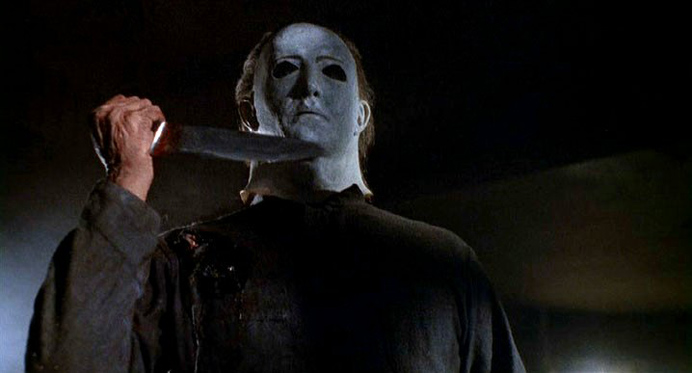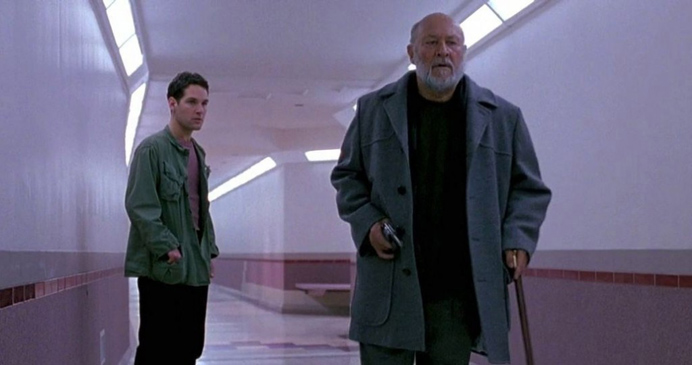
Halloween 4: The Return of Michael Myers (1988)
This time of year always gets me thinking about horror flicks, and there certainly are a lot of them to think about. They’ve been around as long as film itself, and despite evidence to the contrary, they still make horror films today! Whether the ones of today are actually any worse than they used to be is hard to say through the haze of nostalgia, but it is inevitably the American horror films of the 70’s and 80’s that I gravitate to—the films of my childhood. And none fascinate me more so than the Halloween series.
It’s quite a long string of films to sort through, and it may help to break them into more compact units. For starters, we can chop off the ancillary Rob Zombie films. I have never seen Zombie’s Halloween II, and maybe I should—but bottom line, I won’t. His Halloween reboot is terrible enough to turn me off his work entirely. (However, because of my interest in the region, I do want to see The Lords of Salem, which I’m guessing may be a mistake.)
This leaves us with the ‘canon’ Halloween films, but it’s a little misleading to consider them all of the same ilk. I will try my best to simplify the way the films are usually approached, but basically, you can split Halloween fans into two camps: those who love (or even just like) Halloween 4, 5, & 6, and those who don’t.
Halloween came out in 1978, and was followed by a belated sequel, Halloween II (1981), in order cash in on the slasher craze. It picks up immediately after the events of the first film and features the same cast, even down to the smaller roles. This was followed the very next year by a third film, Halloween III: Season of the Witch, which has absolutely nothing to do with the events or characters of the first two, and is simply a horror tale which happens to take place on and around Halloween. As such, it is usually ignored by Michael Myers fans.
After a six year rest came the ‘proper’ follow-up to Halloween II, Halloween 4: The Return of Michael Myers (1988). This film takes as its subject Jamie Lloyd, the daughter of the Jamie Lee Curtis character who died in between films. A year later, it was followed by Halloween 5: The Revenge of Michael Myers, which continued the Jamie Lloyd arc. Six years later, they concluded the Jamie Lloyd arc (as well as hinted at something new) with Halloween: The Curse of Michael Myers.
The cluster of 4, 5, 6 were met with mixed feelings from fans, and are generally seen to be of ever decreasing quality. As such, the producers decided to abandon this story path and do a ‘reboot’ that would make like parts 3 through 6 never happened; they brought back the Jamie Lee Curtis character, living under a new name, for Halloween H20: 20 Years Later. Despite being directed by the great Steve Miner, the film was an extreme disappointment, owing more to the then brand new Scream franchise than the previous Halloween films. H20 had its own sequel, called Halloween: Resurrection, and I don’t have anything to say about it.
All this to say, the series is usually digested one of two ways:
Halloween 1-2 + Halloween 4-6
or Halloween 1-2 + H20 & Resurrection
However, I propose we dispense with those options and follow a new schemata, breaking them into the following units:
Halloween 1-3
or Halloween 4-6
or Halloween H20 & Halloween: Resurrection
I believe the first three films to be a trilogy, one that is linked to late 70’s, early 80’s horror cinema—as well as the John Carpenter style of filmmaking that unifies them—far more than any arbitrary asset like ‘plot’ or ‘character’. Carpenter was the primary force behind the first one, and his guiding hand washes over the second and third as well, linking fear with ancient rituals to create a world of innocence corrupted by an ancient evil that is always lurking in the shadows. Whether the evil behind the mask is The Shape, Michael Myers, or Silver Shamrock, matters not.
H20 and Resurrection are much more informed by the millennium style of filmmaking, as I mentioned before, utilizing the characters and basic mythology of the Halloween films to achieve its own trendy aims.
That leaves us with the middle unit to discuss. If the first trilogy is linked by a thematic and stylistic harmony, the second trilogy is linked by its disharmony. Despite being made almost back-to-back, there is a severe and violent shift in quality, intention, and tone between the fourth and fifth installments. The sixth film attempts to reconcile this, but because of its troubled production history, ends up driving a further wedge into the trilogy, leaving it hopelessly adrift in the cinematic cosmos. It’s a fascinating watch.
Spoilers ahead.
This trilogy takes, as its unifying factor, the character of Dr. Loomis and the town of Haddonfield, IL (but even these elements are presented incosistently, as you’ll see later). Loomis is the doctor obsessed with tracking Michael Myers to his hometown of Haddonfield in the first two films, even when no one believes Myers is a threat. In Halloween 4, he is an old man with horrible burn scars who walks with a cane. He returns when he hears that Myers has disappeared after the ambulance transporting him to his new facility crashes. He rightly deduces that Myers is heading back to Haddonfield to kill his only remaining relative, his niece.

The fourth film plays like a remake of the first, though thoroughly updated in certain technical ways. Since the first trilogy, video had taken over as the way films will live on. Gone is Carpenter’s lush, scope photography and instead we settle in with standard 1.85:1 compositions that won’t lose much in conversion to VHS. Where before, The Shape hovered around the edge of the frame, now he’s front and center, but disappears from cut to cut, materializing right in front of his prey.
Loomis engages the police, who have a hard time believing that Myers will return until it becomes apparent that the whole town is under siege. At one point, there are several Michael Myers surrounding the police; it appears that he is everywhere at once until it’s revealed that it’s a bunch of kids playing a prank. The filmmakers do a good job of exploring the legend of Michael Myers—on one side, The Shape, everywhere and nowhere at once; on the other side, Loomis, who also seems to bend time and space to suit his needs.
The film doesn’t climax with any frightening suspense piece involving Myers; he is simply gunned down by a dozen high caliber firearms until he falls down some kind of well. Then, during the epilogue, an act of violence comes out of nowhere: little Jamie viciously stabs her adoptive mother with a pair of scissors. This is meant to mirror the way her uncle killed his older sister in the opening of the first film.
It’s a strange ending; on the one hand, a satisfying way to end the film, on the other, a ridiculous way to start a trilogy. It’s a hell of an ending to have to begin from, which is one of the reasons the trilogy feels so disjointed—the filmmakers couldn’t honestly carry on from that scene if they wanted to keep to the structure of Michael Myers taking revenge. In fact, all three films end with similarly bizarre acts of violence: the aforementioned stabbing in 4; Loomis stepping away from all character motivation by using Jamie as bait to bash Michael with a bat (using strength that no feeble old man with burns over 75% of his body could drum up); and Tommy, the hero of 6, bashing Myers with a blunt object in what seems to be (and turns out, was) a tacked-on reshoot ending.

The fifth film may be the worst of the trilogy. It feels like one of those lazy made-for-video horror films from the late 80’s. If you’re familiar with the type, you can almost picture it perfectly, from the color, sets, photography, and sound (not to mention the ‘acting’). The film picks up where the fourth one ends, with Michael Myers being riddled with bullets and falling down a well. He finds an old bum at the bottom and sleeps for a year just like Rumpelstiltskin while the bum takes care of him. So far, so good right?
The vibe of the improbable start carries throughout the whole film. The director, a Frenchman named Dominique Othenin-Girard, turns the film into a giant fairy tale, grafting Brothers Grimm on top of Halloween’s own legacy. (One example being the Myers house changing before our eyes to resemble something out of Hansel & Gretel or Rapunzel.)
The results should be more interesting than they are. At the very least, there is more focus on texture than in previous films: we see the sweat brought on by fear, we watch the light reveal the scar tissue on Loomis as a reminder of The Shape’s destruction and the sacrifices made, and best of all, we are shown the infamous mask, shorn of any texture at all, looking like an ancient Greek statue—further linking the evil to antiquity. Reinforcing that is the “Thorn” symbol, a tattoo on Myers’s wrist. It adds an air of mystery to the film, and is entwined with a mysterious traveller who arrives in Haddonfield by bus—we never see his face, only his boots and trench coat. He exists on the periphery of the film until the last scene, where he springs Myers from his jail cell by gunning down the entire police station with heavy artillery, leaving only Loomis and Jamie alive.

The sixth film attempts to link all the mythology together, and starts out quite promising. The filmmakers bring back a minor character from the first film, the young boy Jamie Lee Curtis babysits (played here by Paul Rudd pre-Clueless, although it was released afterward). Immediately, it delves into the mythology of the Thorn symbol by showing a pregnant teenage Jamie (not played by Danielle Harris this time, supposedly because she didn’t care for the disrespect shown to her character) held captive by what appears to be a secret ancient order who uses Michael Myers (controlled by the Thorn symbol?) to their own evil end. While I appreciate the filmmakers trying to make sense of the mess the previous two films did of keeping to a linear story, the film was apparently fraught with production troubles, which led to many reshoots and changes, and in the end, it seems held together by paper clips, which is a far cry from Carpenter’s smooth and seamless original. Another problem was the death of Donald Pleasance, presumably in between some of said reshoots.
Paul Rudd’s character has kept a keen eye on Michael Myers’ various exploits, and seems to have some knowledge (put together from a radio show call-in) that Jamie has just had a child and is on the run from her uncle. He contacts Loomis in an attempt to end the curse of Michael Myers for good. Jamie is then ripped to shreds by a machine that I assume is used in harvesting grain or something or other, and Rudd finds her newborn child in a bus station. He hooks up with Kara Strode, a relative of Jamie Lee Curtis’s adoptive family, who now lives in the refurbished Myers’ House and who’s son is the evil society’s intended next vessel of evil(!). They match wits with Myers and realize the man pulling the strings is Dr. Wynn, an even more minor character from the first film who once told Loomis that Myers can’t drive a car. (Loomis suggests someone gave him lessons and bang, 18 years later we find out that it was Wynn all along that gave him those lessons.)
All this nonsense ends in an underground lair underneath the town hospital (the same one from Part II?) where, as I mentioned earlier, Paul Rudd turns into the wrath of vengeance and repeatedly smashes Michael Myers with a pipe while smiling at him. After a cut to black, we open up on the gang outside the secret lair in their jeep telling Loomis to come with them. Loomis refuses, of course, because he has unfinished business. The heroes drive away without uttering another word. We then cut to the room where Myers was left for dead. Only his mask remains on the floor. We hear Loomis scream a bloodcurdling scream, presumably being murdered off screen—a fitting end for the one character who stuck by the franchise since the beginning(?!?) or a way to address the death of Donald Pleasance the actor when the next sequel is inevitably green lit? Whatever it is, the jokes on them, because the next film forgot this trilogy ever existed.
These three films exist almost as if in a rift in time. In the grand scheme of the Halloween franchise, they can be as important or as inconsequential as one wants. We’re allowed to watch them as a trilogy, individual films, or even individual scenes, like one listens to songs on The Clash’s Sandinista or the entire triple album. The comparison is apt—Sandinista hangs together by the disjointedness of its style, much like these middle Halloween films do.
If looked at as a trilogy, it’s a fascinating one, as there seems to be no way to pull the ship into the port. Even if they want to, the filmmakers just can’t make sense of the proceedings from one film—or even one scene—to the next. It is perhaps the curse of Michael Myers that is preventing them, a cautionary tale of Don’t Fuck With A Masterpiece which hangs like the foreboding Citizen Kane “No Trespassing” sign over the original film.
It may be more realistic and productive to look at the trilogy as merely yet another money-making scheme by the people who struck pay dirt back in ’78 with the original. Horror fans are of course easy targets. They have a sharp critical eye for all things surrounding the films, but they will still line up for tickets no matter what. I count myself among them, with only a few reservations. I’m not blind to the snatch-and-grab schemes of reboots and unnecessary sequels, plot holes and indestructible maniacs. But there is something that haunted my youth from the edge of the frame which keeps me coming back, and has left me picking up the pieces and trying to make sense of them like the man raking his yard in October; no matter how much he rakes, there’s never a shortage of leaves.
In my opinion, Halloween The Curse of Michael Myers is one of the greatest movies ever made – on par with Ridley Scott’s Alien, or James Cameron’s The Terminator.
“Halloween 6: The Curse Of Michael Myers” is BEYOND TERRIBLE. I hope that what you just commented was a joke. I don’t even know where to begin on saying how STUPIDLY IDIOTIC that movie is…
From the ridiculous plot, to the incoherent script, VERY underdeveloped characters, terrible acting, lack of originality, variety of plot holes, lazy writing, near-nonexistent plot, near-nonexistent character emotions, fully nonexistent character development, contradictory arguments to the storyline, unrealisticly stupid characters, farfetched dialogue, unnecessary plotting points, lack of realism or logic, downright stupid ending, and the fact that Michael Myers IMPREGNATED HIS 15 YEAR-OLD NIECE SOMEHOW?! WASNT HIS GOAL TO KILL HER?! THIS MOVIE IS SO BAD THAT I CANT EVEN EXPRESS HOW MUCH I HATE IT.
Well Halloween 4, 5 and 6 are sequels to Halloween 1 and 2 H20 and Resurrection are also sequels to 1 and 2 but they are different, Halloween H20 is based on a sequel when Laurie Strode is alive and is living a different life but Halloween 4 is based when she is dead and she had a daughter (Michael Myers’ niece). 4, 5 and 6 are based on the remaining family of Michael Myers and H20 is based on his sister and Resurrection is based on him returning home.
1 and 2 were supposed to be the only movies, but greed came along.
I believe everyone except for 3 and Ressurection is canon.
Laurie faked her death in H20, guess who dies in H4?
It’s pretty obvious after Micheal kills Jamie and Loomis, he goes back to the police station and finds out where Laurie lives and what happens to her and goes to her to finally kill her.
Resseruction is non-canon. Laurie killed Micheal at the end of H-20.
Micheal survived the gunshots because he had a bulletproof vest and survived the fire because he a had fire retardant clothes and not too much of him burned. Loomis survived because he was blasted out of the room.
Halloween 5 is far and away the strongest of this ‘trilogy’ and easily the finest Halloween sequel after Halloween 2. I find it odd how much bizarre criticism this movie absorbs…to such an extent that I almost wonder how many of its’ critics have actually seen it. If one recalls what set the original Halloween apart, much of it lay in the inscrutability of its’ villain….Michael Myers was the Bogeyman…..he operated according to an agenda that made sense only to himself…he was like an artist of the macabre…there was a strange sportsmanship to his approach. He might stalk you for an hour, and then leave without you ever knowing he’d been there. Or he might kill you on the spot. But when he was in his element, he seemed to regard the easy kill as beneath him. Remember Annie in the laundry room? She got stuck in the window, and was completely at his mercy….and he did NOTHING. It was all about the hunt, all about the game…it was that way with Annie, as well as Lynda and her boyfriend….and it was that way with Laurie Strode. My point is, this ‘cat and mouse’ motif was never again utilized to the same effect in any Halloween movie, before or since, til part 5. Stalking Rachel, and then Tina, in the house….this was all very reminiscent of the original. But as good as that part was, it pales next to the barn sequence. The barn sequence is, in and of itself, better than most complete slasher films. It’s almost LIKE a slasher short film, in fact. The kids get isolated, and Myers lurks in the shadows, waiting and waiting….but when he DID finally act, it was with brutish finality. Look where you will, Halloween 5 is the true successor to the 1978 film. I love Halloween 2….it’s basically perfect. And I like part 4, as well. But 5 brings Myers as close as he’s ever been to the ultimate stalker we saw in the original. Halloween 5 takes the cat and mouse motif to the level of an art form.
I have started to watch H5, with low expectations. But I am nicely surprised.
I agree with Ned Martin in that 4-6 and H20/Resurrection are its own thing. These continueities only loosely follow the canon of the original and II (1981), but only for the purpose of soft rebooting the series with new storylines. Personally, I found Halloween 4 and H20 to be far more entertaining than II, but Halloween 4 is the best sequel after the original. Like Martin stated, it’s essentially a remake of the original, but adds a different take on Carpenter’s, surpassing the”More of the night he came home” tagline with, “The Return of Michael Myers” was more exciting. I can’t speak for H5,6, and Resurrection. I think those have aged terribly, especially 5&6, which I found the former unbearable and the latter just really boring.